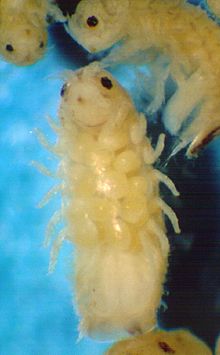Gribble facts for kids
Quick facts for kids Gribble |
|
|---|---|
 |
|
| Limnoria with eggs | |
| Scientific classification | |
| Kingdom: | |
| Phylum: | |
| Subphylum: | |
| Class: | |
| Order: | |
| Family: |
Limnoriidae
White, 1850
|
A gribble is a tiny crustacean that lives in the ocean. These small creatures are a type of isopod, which means they are related to familiar land isopods like pill bugs. Gribbles are usually pale white and measure only about 1 to 4 mm long.
What are Gribbles?
The name "gribble" was first used for species that bore into wood. The very first gribble described was Limnoria lignorum in 1799 from Norway. While some gribbles are famous for boring into wood, others bore into seaweed and sea grass.
Types of Gribbles
There are three main groups, or genera, of gribbles: Paralimnoria, Limnoria, and Lynseia. The Limnoria genus has species found in most seas around the world. Scientists believe that gribbles that bore into living marine plants likely evolved from species that bored into dead wood.
How Gribbles Eat
Gribbles bore into wood and other plant materials to find food. They are unique because they can digest cellulose, which is the main part of plant cell walls. Most other animals that eat plant fibers need help from bacteria in their gut to break down cellulose. Gribbles, however, produce their own special enzyme called cellulase to do this. This amazing ability has even made some biologists think about how gribbles could help with making biofuels.
Destructive Species
Some gribble species can be quite destructive. The most well-known ones that cause damage are Limnoria lignorum, L. tripunctata, and L. quadripunctata. They can cause significant harm to wooden structures in the ocean, like piers and boats.
See also
 In Spanish: Limnóridos para niños
In Spanish: Limnóridos para niños

